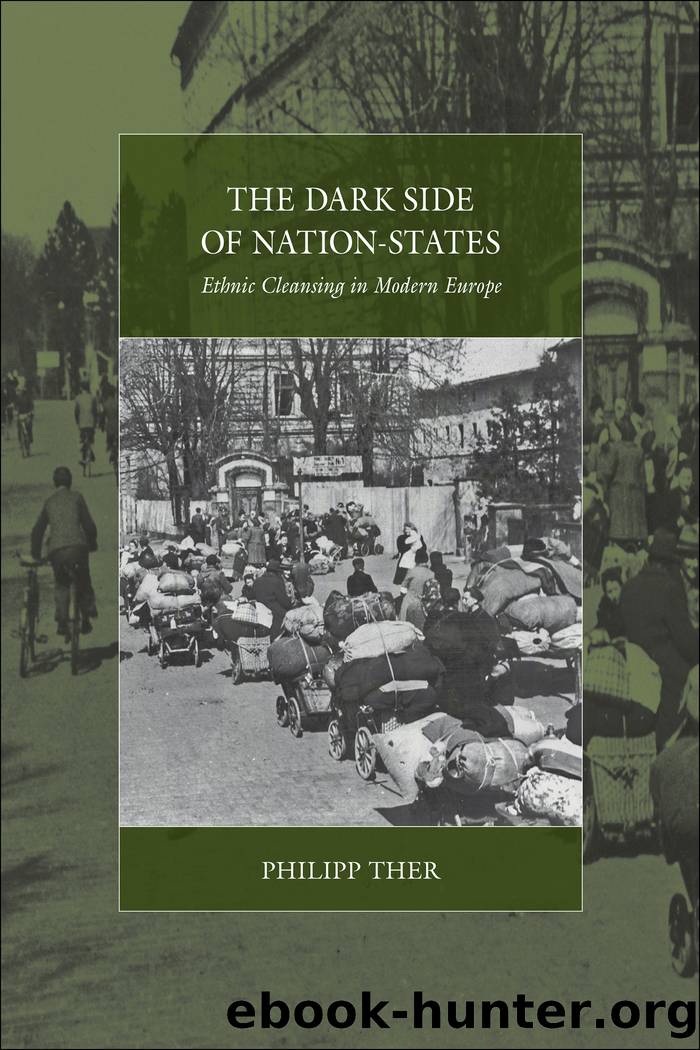The Dark Side of Nation-States by Ther Philipp

Author:Ther, Philipp
Language: eng
Format: epub
Publisher: Berghahn Books
Published: 2016-08-15T00:00:00+00:00
CHAPTER 4
THE BIG SWEEP
POSTWAR EUROPE AND BEYOND 1944â48
Another Escalation: The Allied Plans 1943â45
The Alliesâ postwar framework for peace was just as closely related to the Munich Agreement as the Nazisâ reorganization of Europeâbut in reverse. Germanyâs annexation of the Sudetenland in 1938 had launched a series of population shifts in East Central and Southeastern Europe. Britainâs revocation of the Munich Agreement in July 1942 prompted other population transfers. The dialectical thread linking the conclusion and revocation of the Munich Agreement was an intolerance of national minorities.
Over the course of the war, the focus of Allied plans for Central Europe shifted from forcibly assimilating to removing (the German) minorities. The terminological trend changed accordingly. From 1942, despite frequent references to Lausanne, âpopulation exchangeâ was rarely mentioned in talks in London, which now centered on the idea of âpopulation transfer.â Plans were initially made for no more than the German resettlers, who were to leave Poland again, and a few areas of strategic and economic importance such as Upper Silesia and East Prussia. In the opinion of President BeneÅ¡, some of the German minority could stay in Czechoslovakia. The way things stood in 1943, no more than five to six million Germans were to be affected by the projected removals.
But Germanyâs defeat at Stalingrad changed the course of the war and the scope of Allied designs. From 1943, not only Germans fell into their ambit but also several other nations in the eastern half of Europe, mainly due to Soviet claims to the spoils from the Nazi-Soviet Pact and especially the eastern half of Poland. For a time, it was not clear how far west the Soviet Union would expand and whether it would annex major Polish towns such as Lwów. At the Tehran Conference in November 1943, the âBig Threeâ agreed on the Oder River as Polandâs western border. The Soviet Union was awarded a large part of the Polish eastern territories and the ice-free port of Königsberg. Churchill demonstrated the border changes to Stalin by pushing matches around the conference table.1 Poland, the country most affected by the deals, was not represented, echoing the situation five years previously at the conference in Munich. The Allies, meanwhile, agreed to combine the redrawing of state borders with the âdisentanglement,â as Churchill put it, of ethnic borders.
As the British prime minister admitted in his memoirs, he and President Roosevelt were fully aware in Tehran âthat the three or four million Poles who lived on the wrong side of the line would have to be moved to the West.â2 A year later, Churchill acted as bearer of the bad tidings. In a speech to Parliament on âthe future of Polandâ in December 1944, he declared: âThere will be no mixture of populations to cause endless trouble ⦠A clean sweep will be made.â3 Yet he was optimistic that these population shifts would not present too many difficulties thanks to modern transportation methods and technologies. Nevertheless, he warned the Polish government in menacing tones to comply with this Allied diktat.
Download
This site does not store any files on its server. We only index and link to content provided by other sites. Please contact the content providers to delete copyright contents if any and email us, we'll remove relevant links or contents immediately.
Cecilia; Or, Memoirs of an Heiress — Volume 1 by Fanny Burney(32352)
Cecilia; Or, Memoirs of an Heiress — Volume 3 by Fanny Burney(31726)
Cecilia; Or, Memoirs of an Heiress — Volume 2 by Fanny Burney(31701)
The Great Music City by Andrea Baker(31075)
We're Going to Need More Wine by Gabrielle Union(18890)
All the Missing Girls by Megan Miranda(15299)
Pimp by Iceberg Slim(14177)
Bombshells: Glamour Girls of a Lifetime by Sullivan Steve(13918)
Talking to Strangers by Malcolm Gladwell(13114)
Fifty Shades Freed by E L James(13107)
Norse Mythology by Gaiman Neil(13103)
For the Love of Europe by Rick Steves(12058)
Crazy Rich Asians by Kevin Kwan(9105)
Mindhunter: Inside the FBI's Elite Serial Crime Unit by John E. Douglas & Mark Olshaker(9082)
The Lost Art of Listening by Michael P. Nichols(7347)
Enlightenment Now: The Case for Reason, Science, Humanism, and Progress by Steven Pinker(7076)
The Four Agreements by Don Miguel Ruiz(6526)
Bad Blood by John Carreyrou(6464)
Weapons of Math Destruction by Cathy O'Neil(6068)
